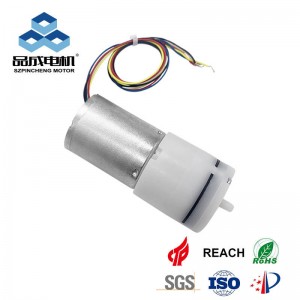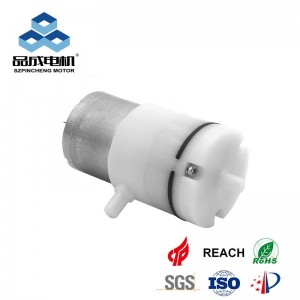In the world of compact automation, medical devices, and cutting-edge technology, the demand for reliable, quiet, and efficient air movement is higher than ever. Enter the Brushless Micro DC Air Pump—a sophisticated engineering solution that outperforms traditional brushed motors in almost every way. This guide delves into what makes these pumps special, how they work, their key advantages, and where they are essential.
What is a Brushless Micro DC Air Pump?
A Brushless Micro DC Air Pump is a compact air pump that utilizes a brushless DC (BLDC) motor to drive its pumping mechanism (often a diaphragm or piston). The "brushless" component refers to the advanced electronic commutation of the motor, which replaces the physical carbon brushes found in traditional brushed motors. This results in a more efficient, durable, and controllable system for generating airflow or pressure in a tiny form factor.
How Does a Brushless DC Air Pump Work?
The operation can be broken down into two parts: the brushless motor and the pumping mechanism.
1. The Brushless DC Motor:
-
Electronic Commutation: Unlike brushed motors that use physical brushes to transfer current to the spinning commutator, BLDC motors use an integrated electronic circuit (a controller) to precisely energize the motor's coils in sequence. This creates a rotating magnetic field that turns the permanent magnet rotor.
-
Hall-Effect Sensors: Many BLDC pumps include sensors that provide real-time feedback on the rotor's position to the controller. This allows for extremely precise speed and torque control. Sensorless designs use back-EMF to determine position, reducing cost and complexity.
2. The Pumping Mechanism:
-
Diaphragm Design: The most common type for micro pumps. The motor's rotary motion is converted into a reciprocating motion via an eccentric cam or connecting rod. This moves a flexible diaphragm back and forth, creating a vacuum to draw air in on one stroke and pressure to expel it on the other.
-
Piston Design: Some models use a miniature piston for higher pressure applications. The principle is similar, with the motor driving a piston within a cylinder.
The marriage of a precisely controlled BLDC motor with this pumping action results in exceptionally smooth, reliable, and efficient operation.
Key Advantages of Brushless Micro DC Pumps
Why are brushless motors becoming the gold standard? The benefits are substantial:
1. Exceptional Longevity & Reliability:
-
No Brush Wear: The primary point of failure in brushed motors—the physical brushes that wear down over time—is eliminated. This dramatically extends the pump's operational lifespan, often by a factor of 2x or 3x.
2. High Energy Efficiency:
-
Reduced Friction & Heat: Without brush friction, less energy is lost as heat and noise. More electrical energy is converted into useful mechanical work. This is critical for battery-powered devices, as it significantly extends battery life.
3. Precise Speed & Flow Control:
-
Intelligent Control: The electronic controller allows for exact speed adjustments via Pulse Width Modulation (PWM) or voltage changes. This enables designers to fine-tune airflow and pressure on the fly for sophisticated applications, something difficult to achieve with brushed motors.
4. Low Electromagnetic Interference (EMI):
-
The arcing that occurs between brushes and a commutator in traditional motors generates significant electrical noise. BLDC motors produce much less EMI, making them ideal for sensitive electronic environments like medical and diagnostic equipment.
5. Compact Size with High Power Density:
-
BLDC technology allows for more power in a smaller package, enabling miniaturization of end products without sacrificing performance.
Common Applications
The unique benefits of brushless micro DC air pumps make them indispensable in high-value, performance-critical fields:
-
Medical & Diagnostic Equipment: Portable ventilators, respiratory therapy devices, blood pressure monitors, and automated drug delivery systems. Their quiet operation, reliability, and precise control are paramount.
-
Professional Aeriation: High-end aquariums and hydroponic systems where silent, 24/7 operation is required.
-
Automotive & HVAC: Seat massagers, pneumatic control systems, and sensors in vehicles.
-
Portable Electronic Devices: Cooling systems for compact projectors, wearable devices, and other electronics requiring active thermal management.
-
Industrial Automation & Robotics: Powering small pneumatic grippers, actuators, and sampling systems in collaborative robots and automated machinery.
Brushless vs. Brushed Micro Air Pumps: A Quick Comparison
| Feature | Brushless Micro DC Pump | Brushed Micro DC Pump |
|---|---|---|
| Lifespan | Very Long (10,000+ hours) | Shorter (1,000-3,000 hours) |
| Efficiency | High (longer battery life) | Lower (shorter battery life) |
| Control | Precise electronic speed control | Limited, voltage-based control |
| Noise Level | Quieter operation | Louder, due to brush friction |
| EMI | Low | High |
| Initial Cost | Higher | Lower |
When to Choose Brushless: For applications where reliability, quiet operation, battery life, and precise control are critical (e.g., medical, high-end consumer products).
When Brushed Might Suffice: For very low-cost, intermittent-use applications where ultimate performance and longevity are not primary concerns.
How to Select the Right Brushless Micro Air Pump
Consider these specifications when choosing a pump:
-
Voltage (V): Common voltages are 12V, 24V, or 5V for USB-powered devices.
-
Flow Rate (LPM or CC/M): The volume of air it can move (Liters per Minute or Cubic Centimeters per Minute). Determine your required airflow.
-
Pressure (kPa or mmH₂O): The maximum pressure the pump can generate. Vacuum pressure is also key for suction applications.
-
Noise Level (dB): Critical for medical and consumer devices. Brushless pumps are quiet, but levels can vary.
-
Size & Weight: Ensure the physical dimensions fit your product's form factor.
-
Control Interface: Check if simple voltage control is sufficient or if you need a PWM input for advanced speed control.
-
Certifications: For medical use, look for pumps with relevant certifications.
Conclusion
The brushless micro DC air pump is a transformative component that enables a new generation of smart, portable, and reliable products. While the initial investment is higher than that of brushed alternatives, the returns in longevity, efficiency, and performance are undeniable. Whether you're designing a life-saving medical device, a high-end consumer product, or a sophisticated robot, specifying a brushless micro air pump is a decision that ensures quality, reliability, and customer satisfaction for years to come.
you like also all
Post time: Aug-31-2025




